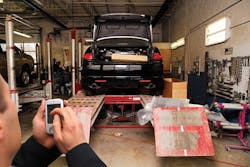In the whirlwind of running a collision repair center, it’s easy to overlook a simple, valuable investment you can make in your business: creating and updating your employee handbook. The latest in handbook hotspots? Recent technologies including texting, iPods, cell phone cameras and smartphones. As these gadgets become common, it’s important your employees understand your expectations about personal technology in the body shop.
Vehicle Information Services Inc. chief counsel Erica Eversman, experienced with employment law and its intricacies within the collision repair industry, says the benefit of an employee handbook is that it outlines specific employment expectations. “It gives everybody a fair sense of where they’re at in the employment relationship, [and] the things that are expected—and not expected—of them.” Spelling out employee expectations provides you with the opportunity to mandate specific policies regarding the use of technology in the workplace. Here, Eversman shares her insight on how to effectively communicate some of those policies.
WHAT TO ADDRESS RIGHT NOW
Handbook Hotspot #1: Texting. In today’s tech-obsessed workforce, Eversman says texting has become a big problem, especially given the work environment of a collision repair center. “It’s like texting and driving,” she says. “If you’re operating machinery, it could be dangerous.” While you could ban all texting, Eversman suggests exceptions can and should be made where appropriate. For example, let’s say you have an employee whose wife is pregnant. “If the employee is waiting for the [text] that says she’s in labor, now what?” Situations like that can be addressed in your employee handbook.
Policy example: “Texting is not permitted at work. However, management may make exceptions for emergencies and pregnancy-related issues. These situations must receive written employer approval beforehand.”
Handbook Hotspot #2: iPods. Many employees enjoy working while listening to their favorite tunes, but it’s not a good idea to allow the use of ear buds with iPods. “Hearing is a significant safety issue,” Eversman says. “[You] don’t want someone in his or her own little world [and a co-worker] on the floor bleeding.” That may sound extreme, but in an auto body shop full of heavy machinery and sharp tools, injury is a possibility. Eversman suggests allowing employees to rock out to the radio instead.
Unlike texting, this is a policy that’s best not left open to special circumstances. As soon as you give an explanation of why you don’t want employees to do something, Eversman says, that just opens up the door for a potential argument. For example, she says someone may then ask, “If the reason you don’t want me to use an iPod with headphones is so I can hear things, why can’t I use my iPod with a docking station?” Better to avoid the situation entirely.
Policy example: “We do not permit the use of headphones or iPods.”
Handbook Hotspot #3: Camera phones. This may not seem overtly important, but it’s smart to prevent your employees from taking pictures with their cell phones while at work. The last thing you want is for them to post their snapshots on a website like Facebook. “[It’s] not even so much about the time wasted,” Eversman says. “Shops have developed their own streamlined processes and interesting setups—how tools are arranged, a particular process about how cars are moved from location to location, a unique way you have electrical outlets hung throughout your building.” Worst-case scenario, a competitor sees the photos on a social networking site—thanks to your photo-snapping employees. Eversman says it’s important to stress confidentiality regarding shop operations and procedures.
Policy example: “Employees may not take photographs in the workplace, other than for approved work-related purposes and with employer cameras. All photos are property of the collision repair center. No photos may be release_notesd or posted on social networking sites or other public venues without written supervisor approval.”
SMART BUSINESS
Given the possible scope of an employee handbook—which may extend well beyond the emerging technologies covered here—it’s worth considering hiring an attorney to write or review the document. “You don’t want to put things in there that may violate the law,” Eversman says. She estimates that for about $1,500 you can have a lawyer draft your entire policy manual. A review of your own work ought to cost a little less.
Eversman also suggests including an arbitration clause in your handbook. This ensures that any grievances an employee may have will reach resolution outside the courts. If you do enter into arbitration at some point, Eversman cautions, work with an arbitrator familiar with the collision repair or automotive industries.
Despite the complexities of technology and privacy issues, keep your handbook as short as possible and easy to read (especially if you’ve hired an attorney to write the manual!), as confused employees won’t bother to finish reading it. Another way to motivate employees to read the manual: require their signature, indicating they’re aware of and in agreement with your shop’s policies, expectations and procedures. Eversman recommends reviewing your handbook at least once a year and updating it whenever there are changes in the law or company policy.
The greatest value in creating a thorough and updated handbook is that it allows your business to run as efficiently as possible—and it also makes your employees feel more comfortable as well. “[Employees are] always happier when they know what’s expected of them,” Eversman says.



